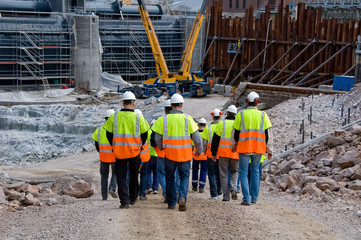Personal Protective Equipment, known as PPE, is the armour worn by workers in various industries to protect against physical, electrical, chemical, and infectious hazards. While the word 'PPE' often conjures images of high-visibility vests and hard hats, the reality is a vast and diverse range of equipment tailored to critical roles across sectors. Understanding the right PPE for different work environments is not just crucial for compliance with safety regulations but is a pivotal step in safeguarding the most important asset of any business – its people.
In this detailed exploration, we'll unpack the distinctive PPE requirements for some of the most integral work sectors, including construction, healthcare, and manufacturing, and how such gear plays a crucial role in the daily safety regimen for countless workers globally. This post aims to provide a valuable resource for safety professionals, workers, and industry members navigating the ever-important terrain of workplace safety.

The Central Role of PPE in Work Safety
Workplace safety is not a one-size-fits-all equation. It demands a nuanced approach that is as varied as the tasks performed on the job. Personal Protective Equipment (PPE) is a critical part of this safety panorama and serves as the final layer of defence after engineering and administrative controls have been applied.
By its very nature, PPE is intimate with the tasks workers perform and the hazards they face. It extends the body's natural defences where they may falter and, in doing so, reduces the risk and severity of workplace injuries and illnesses. From the construction site to the hospital floor, and the workshop in between, PPE stands as a testament to the adaptability and crucial role in mitigating industry-specific risks.
Personal Protective Equipment and PPE Workplace Safety
Across a multitude of sectors, Personal Protective Equipment (PPE) stands as a bastion of safety, critical in minimizing exposure to harmful substances and ensuring a safe working environment for employees. Industries that heavily rely on PPE include the construction, pharmaceutical, oil and gas, and automotive sectors, each facing unique risks that require specialised protective gear. For instance, in the construction industry and oil and gas sectors, safety helmets, safety boots (or safety shoes), and protective gloves are indispensable for workers performing tasks in high-risk environments, such as confined spaces or areas where exposure to dangerous chemicals is a concern. These items protect against serious injuries to the feet, hands, and head – areas most affected during accidents.
In the pharmaceutical industry, where the risk of exposure to biohazards and chemical substances can affect the skin and mucous membranes, wearing adequate PPE such as protective gloves and safety glasses is vital. This gear ensures that employees are safeguarded from contact with any harmful agents while handling production jobs or during research and development processes.
Furthermore, in all these industries, the emphasis is not just on providing the right PPE but also on proper training for employees on PPE use. This education helps teams understand the importance of wearing their gear correctly and consistently, reinforcing the company's commitment to maintaining a safe working environment.
Businesses must recognize that investing in high-quality PPE and ensuring its correct usage is imperative, not only for compliance with safety regulations but more importantly, for the protection of their most valuable asset— their employees. In sectors known for challenging and potentially hazardous working conditions, PPE acts as a critical tool in safeguarding against injuries and creating a culture of safety that permeates every level of operation.
PPE in Construction: Safeguarding Against Site-Specific Hazards
Construction is renowned for its dynamic and often hazardous conditions. In this high-risk environment, PPE is more than just a set of protective gear; it's a lifeline. Different work zones within construction demand unique PPE to address site-specific hazards:
Head Protection
For construction workers, the hard hat is an iconic symbol of safety. It guards against falling materials, head bumps, and electric shock, which are common risks on any site. The use of hard hats extends the prevention of severe head injuries during daily tasks such as working at heights, moving materials, or operating heavy machinery.
Eye and Face Protection
The eyes are susceptible to a variety of hazards, from dust and grit to high-velocity impacts. Safety glasses with side shields or goggles are mandatory for anyone working with tools and materials that pose an eye-risk. In cases where chemical exposure is possible, face shields and goggles become imperative, providing a barrier against hazardous liquids and vapours.
Hearing Protection
Construction workers are routinely exposed to high noise levels which, over time, can lead to significant hearing loss. Equipment like earplugs, earmuffs, and noise-cancelling headphones are fundamental for protecting the delicate auditory senses from the sustained roar of construction equipment and power tools.
Hand and Foot Protection
From cuts and punctures to crush injuries, the hands and feet are among the most frequently injured body parts in construction. High-quality gloves and sturdy, puncture-resistant boots can make the difference between a minor scratch and a life-changing injury.
PPE in Healthcare: A Shield Against Invisible Threats
Healthcare has its own set of invisible hazards - pathogens. Medical professionals, now more than ever, understand and rely on PPE to protect themselves and patients. The landscape of required gear is varied and extensive, reflecting the complexity and acute nature of the hazards faced:
Gloves
Disposable gloves are the frontline defence against contamination and infection. They are ubiquitous in healthcare and are made from different materials, each serving a specific use from patient care to dealing with biohazards.
Masks and Respiratory Protection
Respiratory hazards in healthcare can be as diverse as airborne pathogens, gases, and even small particles during surgeries and procedures. Masks, as PPE, are designed to filter out these hazards, offering workers a barrier against inhalation threats.
Gowns and Aprons
To prevent the spread of infection, healthcare workers use gowns and aprons to protect clothing and exposed skin. These are especially important in areas with potential splash risks or close patient contact.
Eye Protection
Healthcare workers also use face shields, glasses, or goggles to protect from hazards that could lead to eye injury or infection. These may be a necessary addition to respiratory protection when there is a significant risk of airborne pathogen exposure.
PPE in Manufacturing: Defending Against Operational Risks
Manufacturing settings are rife with potential hazards, from punctures to repetitive strain injuries, and the PPE required is highly specialized to keep up with the challenges of the sector:
Protective Clothing
An array of suits, coveralls, and aprons are employed in manufacturing to shield workers from physical hazards like heat, flame, sparks, and chemicals. This includes flame-resistant (FR) clothing for fire-risk areas and chemical suits for dealing with hazardous substances.
Hand Protection
The hands are at the forefront of virtually all manufacturing processes and, as such, are exposed to a range of risks, from cuts and abrasions to chemical exposure. Gloves in manufacturing range from basic leather work gloves to intricate chemically resistant options, all aimed at safeguarding against the specific activities and hazards involved.
Hearing and Eye Protection
With the din of machinery and the possibility of flying particulates or metal shavings, robust hearing and eye protection are paramount. Industrial earmuffs and earplugs dampen the noise, while safety glasses and goggles ward off ocular threats.
Respiratory Protection
In environments where dust, fumes, or other airborne contaminants are present, proper respiratory PPE becomes crucial. This includes everything from basic dust masks to sophisticated air-purifying respirators, depending on the concentration and toxicity of the substances.
Comparison of PPE Across Industries
While the genres of PPE may differ significantly between construction, healthcare, and manufacturing, the philosophy driving their use remains constant – the safeguarding of workers. There are, however, notable similarities and differences in their application:
Similarities in Usage
All three sectors share a reliance on the core PPE components - head, eye, face, hand, and foot protection. They also echo the need for respiratory and hearing protection, albeit in varying frequencies and severities.
Tailoring to Industry Requirements
The differences lie in the fine print. In healthcare, the focus is largely on protection from pathogens, where in construction and manufacturing, the emphasis is more on physical and environmental hazards. Each industry tailors PPE to address its unique risks, resulting in distinct usage patterns.
The Role of Training and Maintenance
Amplifying these distinctions is the role of training and maintenance. PPE must not only be suited to the tasks but must also be properly maintained and worn correctly. The success of PPE in mitigating risks is fundamentally tied to the knowledge and compliance of the workers.
The Significance of Industry-Specific PPE
Understanding that industry-specific PPE is much more than a regulatory box to tick is paramount. It's the difference between safety and vulnerability, between productivity and downtime, and between protection and risk. Each piece of PPE is a bespoke tool in the toolkit of workplace safety, and it’s this tailored approach that underpins the holistic safety efforts across industries.
Safety in the Oil and Gas Industry: Ensuring Worker Protection through PPE
In the high-risk environment of the oil and gas industry, ensuring the safety and well-being of the team is paramount. The unique hazards faced by workers in this sector, including explosive materials, airborne toxins, and extreme temperatures, necessitate comprehensive measures to minimize exposure and risk. Central to these protective measures is the requirement for personal protective equipment (PPE) that is specifically designed to offer body protection against the myriad dangers inherent in oil and gas operations. From safety gloves that protect against chemical burns and cuts, to specialized suits that guard against extreme heat or cold, the use of PPE is intrinsic to maintaining a safe work environment. The oil and gas industry exemplifies how stringent PPE requirements, when correctly implemented, can significantly contribute to an overall strategy to ensure safety and prevent occupational injuries and illnesses.

Conclusion: The Unified Goal of PPE Diversity
The mosaic of PPE across industries tells a compelling story of adaptability and resilience. While each sector has its own narrative of risks and protections, they all contribute to one overarching book – the pursuit of safe and sustainable work environments.
By recognising and appreciating the unique PPE needs of construction, healthcare, and manufacturing, safety professionals and workers can ensure that their respective industry standards are met with precision, care, and a relentless focus on human welfare. This is not just about complying with regulations; it's about fostering a culture of safety that respects the diversity of the workforce and the challenges they conquer daily.
PPE is not a one-helmet-fits-all affair; it's a personal and collective victory against the tides of risk that lap at the shores of every industry. It's about knowing that whether it’s the scalpel in the operating room, the welding torch in the construction site, or the assembly line in the factory, the armour is there, ready to defend, adapt, and protect. And in this assurance, we find the thread that weaves together the robust tapestry of industrial safety.
For more in-depth insights into the world of PPE and how it relates to your specific industry, stay tuned to our blog where we will continue to unpack these critical topics with thoroughness and care. Remember, in the grand orchestration of work safety, every piece, big or small, matters, and PPE is the silent, reassuring note that holds the melody together.
